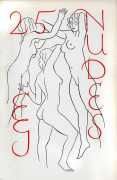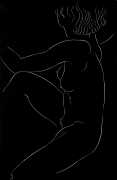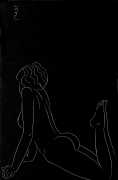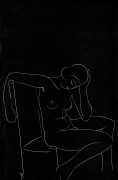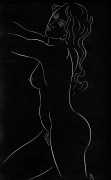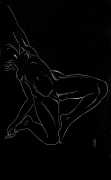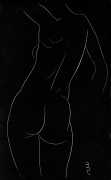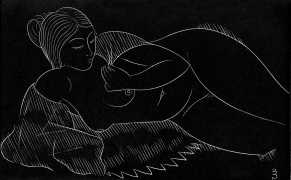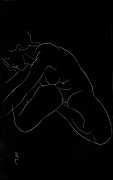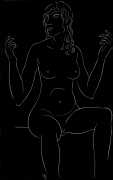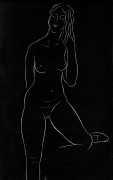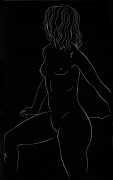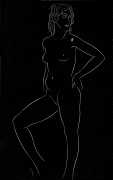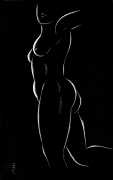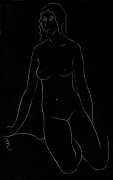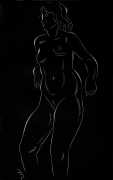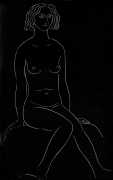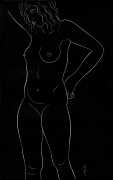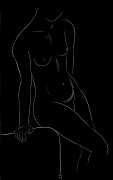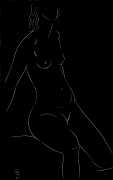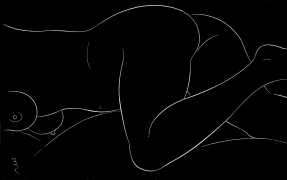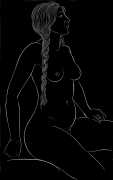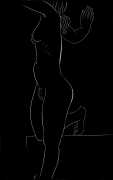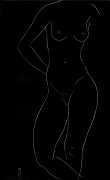
Eric Gill’s small red-bound book Twenty-five Nudes is both a record of how he believed the human body should be portrayed, and the written rationale for that approach. We have reproduced the introduction to his book below in its entirety, as he explains his way of working much better than any synopsis could. The crux of his argument is that ‘drawing, like any other art, is not merely a means to an end; drawing is worth doing for its own sake’. It is a very zen approach, and maybe one that could usefully be taken to heart by anyone wanting to explore their artistic creativity.
Twenty-five Nudes was published by J.M. Dent for Hague and Gill.
ERIC GILL’S INTRODUCTION
It is commonly taught in choirs and places where they sing of such things that the study of nature and particularly of the human body and its anatomy and learning to draw from the living model are the first necessities in the training of the serious ‘art’ student. The proper study of mankind is man, and this study is supposed to be chiefly a matter of having a good look. ‘First I look and then I draw my look.’ This theory of art training has had a run of three or four centuries and we have now reached saturation point. We now at last realise that the child who said, ‘First I think and then I draw my think’ was not only much righter but was also in line with the theory of all the previous centuries and the practise of the whole human world from the beginning of time, saving only such times and places which, like our own, had retreated from the general notion that human making is primarily a product of human imagination.
The idea, then, that drawing from life is the first thing to be done is now discarded, and we may now say that if you are going to draw from the naked model at all the best time to do it is rather later in life, when the experience of living has filled the mind and given a deeper, a more sensual as well as a more spiritual meaning to material things. It is doubtful however whether it is ever desirable to employ professional models and to treat drawing from nature, whether vegetable or animal, as part of school education. What is wrong with your friends and relations? Perhaps they haven’t specially perfect figures; but that is not the point; for in any case it is what is in your own head that matters most and not what the model has in his or her own body. The draughtsman is not primarily a photographer; he is primarily that kind of artist who by means of lines makes a sort of house to dwell in. Just as we dwell physically in houses of bricks and stones, so we dwell mentally in constructions of lead and chalk and paint. And you must know what living is before you can build a house.
For drawing, like any other art, is not merely a means to an end. Drawing is worth doing for its own sake; it is subordinate to no other end than the general end of life itself – man’s final beatitude. Of course it is right and proper when you have some particular work in hand to make sketches and preliminary models to guide you. If you are carving a figure to fit a certain place, it would be absurd to proceed regardless of dimensions and expect the builders to accommodate their building to your carving. For this reason a preliminary drawing or model is commonly necessary. And, in the same way, if you have to make a figure representing a particular meaning and therefore standing in some particular attitude, it is generally desirable to make preliminary drawings in order to work out the relations of one part to another. For this purpose a living model may sometimes be useful, provided you don't take it too seriously. For you can seldom get a living person to stand just exactly as you wish and you would be quite wrong to let the model dictate.
These things being admitted, the main point remains: drawings are ends, not means, and even studies and sketches should be thought of as worth doing for themselves. And this point of view is in line with the general rule that drawing from life properly comes late in life rather than early. For the training of imagination is the first thing to be seen to, and that is best achieved by life and experience; and in order to make this particular thing, this construction of lines derived from the sight of human limbs and bodies, the artist is more dependent upon his life and experience than he is in any other business. We are creatures who know and will and love. What do we know and will and love? Whatever else may be said, we know and desire and love one another in a physical manner. There is no escape from this and no denying it. Does anyone want to escape or deny? Perhaps the Buddhists want to escape; perhaps the Puritans would deny. But the rest of us accept the fact and are glad.
Drawings of the nude, therefore, have a special place in human affairs and a special veneration, and as human life is not all a matter of tears and sighs, but also, and equally and even more importantly, a matter of laughter, there is naturally a comic side to all this. Don’t let’s be too solemn about it. Hair on the belly is certainly very becoming but it is also extremely amusing – quite as amusing as hair on the head. Man is matter and spirit, both real and both good, and the funny is certainly a part of the good. The human body is in fact a good joke – let us take it so.
The only serious and solemn part of drawing from the life is the technique itself. How to draw? That is the serious question. What is drawing? To draw is to drag or pull something along, and in this matter it means dragging or pulling a pencil or brush along the surface of paper. We may agree perhaps that pushing a graver is, by a sort of licence, also a kind of drawing – drawing backwards. Smudging about with tones and colours is not drawing, though such things may appropriately be added on occasion. Good drawing, then, means good lines – clean lines, clear lines, firm lines, lines you intend and not mere accidents. That’s all there is to it. But a line is not in practice what Mr Euclid says it is. It has width as well as length. There are two edges to it, and therefore if a line represents a contour it follows that the said contour is represented by one edge or the other; it cannot be represented by both. The draughtsman must remember this. It is almost the first rule to be taught and the last to be learnt. Do you think of your line as a narrow portion of the surface of the thing you are drawing, or as a narrow strip of its background? Your pencil cannot be absolutely sharp-pointed. It makes a line with two edges. Which edge is the contour you are drawing?
I do not claim that the twenty-five nudes which follow are good examples of drawing. Curates’ eggs are the commonest objects of the countryside. I only hope that some of them will be found pleasing and that other and better draughtsmen will follow my example and produce books of life-drawings which are ends in themselves and not mere studies by the way.


